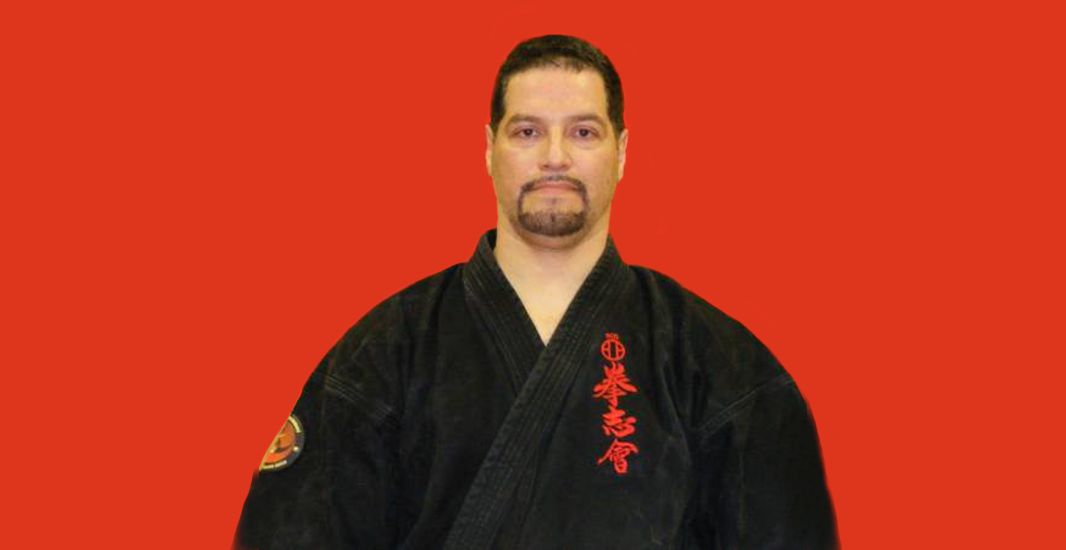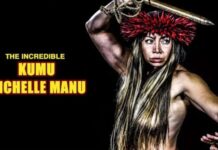As one grows up surrounded by the familiarity of home, one’s neighborhood, and the everyday people that cross one’s life, the world appears to be vast, and other places remote. The distance between one’s world and everywhere else seems intangible and one never thinks that one day one might feel differently about things.
Luis Morales grew up in an isolated speck on the planet, the SouthBronx, in New York City, an urban enclave during turbulent times,but nonetheless a world onto itself.
The paths that Luis Morales has taken have no doubt changed his life. But one unshakeable reality met was realizing that the world is not that large at all. Not when your journeys in life can cross milesfrom reaching out to other worlds; now they are a part of yours. His world took him down the path of karate training, which inevitablybrought him to Okinawa. The rest is history.
Luis Morales Kyoshi holds rank of 8th Dan for Kenshi-kai Goju-Ryuand is the North American Chief Instructor for Kenshi-kai OkinawaGoju-Ryu. No doubt, he is many things to his students, his family,fellow martial artists, instructors and the countless individuals whohave met and known him.
After our first and second (yes, we just had to return for more)interviews with Luis Morales Kyoshi at his dojo, Budo QuestMartial Arts Center in North Arlington, New Jersey, my editor and I wanted to coin a word that would best describe him: brilliant, gifted, humble, dynamic, practical. He is all the above.
Morales Kyoshi best summed it when we asked him, “What is yourmantra?” He quickly replied, “Always a student first or Shoshin, meaning,beginner’s mind.”
After practicing karate for 39 years, Morales Kyoshi firmly believesthat learning never ends that there is always more knowledge toacquire today and always tomorrow.
Budo Quest Martial Arts Center is also the headquarters for Kenshi-kai Goju-Ryu Karate-Jutsu Kobu-Jutsu Association as well as TheBugaku Renmei (Martial Arts Federation).
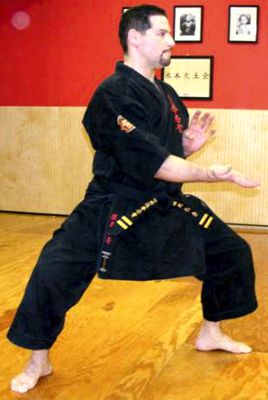
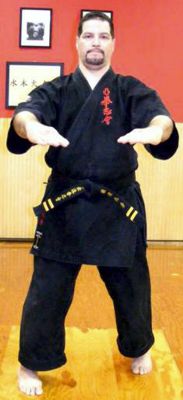
The following is our in depth interview with Luis Morales Kyoshi at Budo Quest Martial Arts Center March, 2009.
The Beginning
Martialforce: You grew up in the Bronx during the 1970s, when the streets were rough and times were tough. Were you were ever attacked?
Luis Morales: “Yes, it was when I attended Junior High School 44. It was lunchtime and I was with some of my friends. On that particular day, I had on my nice leather jacket. A group of high school guys came up to us, jumped me and ripped me of my jacket. None of my friends came to my help.”
Martialforce: What went through your mind after that incident?
Luis Morales: “Do not count on your friends (Laughs)!”
Martialforce: Growing up, were you exposed to any form of martial arts training?
Luis Morales: “As a little kid I would buy any martial art magazine I could get a hold of and read them cover to cover. At the age of 8, I would watch a family friend named Elias, who practiced Miyama Ryu, a Ju-Jitsu style. As many times, as I asked him to teach me he would always tell me I was too young. I knew then that I had to study some form of martial arts.”
Martialforce: When did you begin studying the Martial Arts?
Luis Morales: “I began officially at the age of 12.”
Martialforce: Where did you begin?
Luis Morales: “I joined the Tremont School of Judo and Ju-Jitsu and began with Tae Kwon Do. I later began training in Shotokan at the Bronx Shotokan Karate Club in the South Bronx. My instructor was Philip McRae and Errol Razor. Sensei Razor later awarded me my black belt. It was a very tough dojo. Through a mutual friend I met Steven Hernandez Sensei who introduced me to Goju-Kai.”
Hernandez Sensei taught me Gekisai Dai Ichi, Ni, and Saifa. He later introduced me to Japanese Gojuryu instructor Teddy Wong Sensei. I trained with Wong Sensei for about a year and a half.
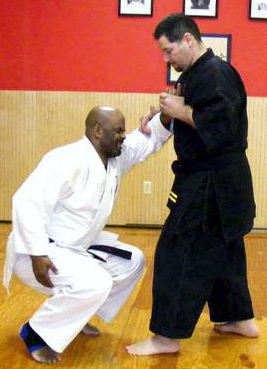
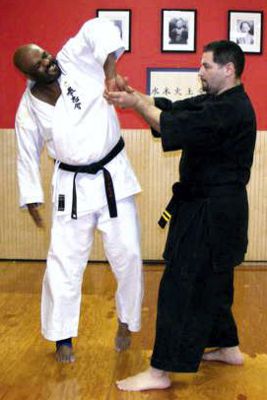
I was really hooked with both arts, training in Shotokan three times a week and Goju-Ryu twice a week.
Later, Hernandez Sensei introduced me to Raymond Duran Sensei who was a Sandan under Gogen Yamaguchi but had left the Goju-Kai and started doing the Shoreikan style of Goju-Ryu under Thomas Boddie Sensei. Duran Sensei was teaching Shoreikan, with Goju-Kai style Kumite.
After I was promoted to shodan in Shotokan, I stopped training in that style because I immersed myself in the Goju Ryu. I loved its footwork, its angles and Sanchin Kata.”
When it came to fighting it was Goju Kai fighting, fighting from the cat stance and kicks to the groin. No holds barred, which was what Duran Sensei, taught. He was extremely rough. I was with Duran Sensei for a few years. He stopped teaching Karate completely because he was disgusted with the politics.”
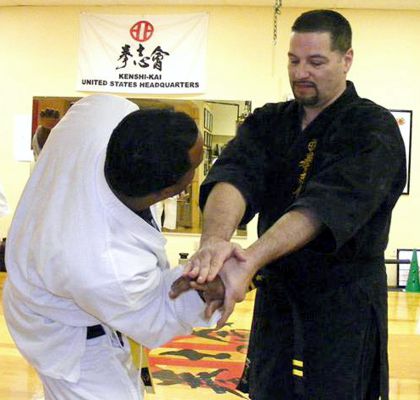
Martialforce: For a while, you practiced Japanese Goju style kata, and then later switched to Okinawan form. Did this change have an effect on your art?]
Luis Morales: “No, it did not. I just went with its flow, and I saw where it made sense. I also learned that one should never be stuck on any a system as the ‘only way’. Some folks do and claim that it is the one, the best. That to me is thinking foolishly.”
Martialforce: Did you ever find fault in your instructors for not teaching you particulars you later learned?
Luis Morales: “No I did not. It was not a weakness on their part if they were never taught and able to hold them in their arsenal to share with their students. Remember, the first generation of martial arts students in the U.S. was mostly service men that had just fought a war against Japan. Along the way, they were shown various aspects or forms of karate. Do you think most Japanese instructors were open to teaching Americans the real deal or knew to hold back?”
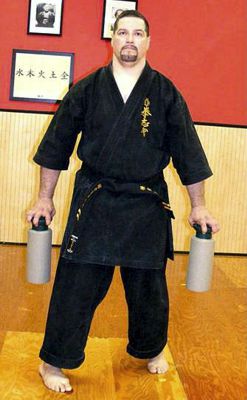
Martialforce: When did training change for you?
Luis Morales: “Well, it was when I was exposed to old style Karate by way of Oyata Sensei. Back in the 1980s, Oyata Sensei would demonstrate Karate and the true applications of kata. A friend of mine from Canada sent me a tape of this Okinawan gentleman who was knocking out people left and right.
One weekend, I was visiting Canada at the same time Oyata Sensei was there holding a seminar. I attended the seminar and witnessed him first hand. This was perhaps back in 1984. As he demonstrated the movement of a kata, an opponent would come towards him to attack and each would be knocked out. This power made a lasting impression on me.”
Martialforce: In attending seminars with Oyata Sensei, did he teach you Goju kata?
Luis Morales: “Oyata Sensei is not Goju Ryu; he is Okinawa Kempo ‘Old style karate from Okinawa.’”
Martial force: He applied his principles to Goju-Ryu.
Luis Morales: “Well, every karate style has movements that have similarities. Training with Oyata Sensei opened my mind where I questioned if Karate was not just about kick and punch. Karate has joint locking; karate is knockout points. This perception stayed with me.”
Martialforce: Tell us about one of his moves you witnessed.
Luis Morales: “Do you see this movement in Pinan Kata? He threw a nukite strike where his finger went right into stomach 9, a vital point. His opponent was knocked out, I mean out.
It was my desire to increase my knowledge that motivated me to search other Goju-Ryu instructors. I later met Tetsuhiro Hokama Sensei. When I asked him why Karate is presented as just kicks and punches, he simply restated what I felt all along: Karate is not just kick-punch.”
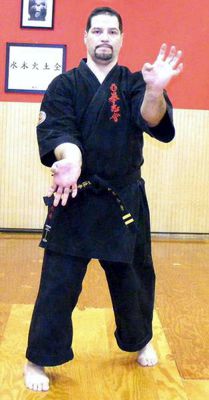
Martialforce: Did Hokama Sensei teach you Goju?
Luis Morales: “Yes, Hokama Sensei took my Goju to another level. I studied Goju with Master Teruo Chinen, Chief Instructor of Jundokan International and a student of Grandmaster Eiichi Miyazato, 10th Dan and founder of Jundokan. I was also a student of Miyazato Hanshi.
I attended a seminar given by Chinen Sensei and truly admired how he performed Goju-Ryu kata. I later went to Spokane, Washington to his annual Gasshuku. The training was tough, but I loved it! I joined Chinen Sensei. He recognized me as a Yondan when I joined his group.”
Martialforce: Were you studying with Chinen while with Miyazato?
Luis Morales: “I resigned from Chinen and later on studied under Miyazato. Chinen had beautiful kata, and he was a training machine, but there was no Bunkai. It was an aspect of the art he did not teach.”
For about a year, I studied under Miyazato and was affiliated with him. It was during that time that I met Hokama Sensei. I later resigned from Miyazato and began studying under Hokama Sensei.”
Martialforce: Did Hokama Sensei change your kata?
Luis Morales: “No, and that is what I liked most about him. He never maintained to knowing and teaching the one true way of Goju Ryu. He never claimed to any of that nonsense, “I am the true inheritor; I know all of the secrets.” Instead his approach was, ‘Hear me and listen to what I will teach you. Apply it and you do not have to change your kata. You have good kata; you have Jundokan Kata, good lineage and a good understanding. Just listen to my theory.’”
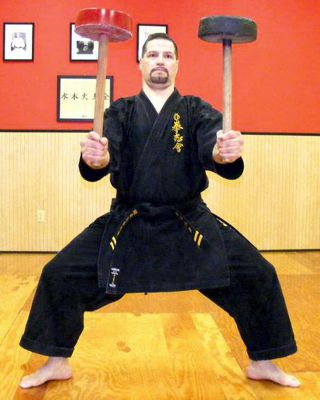
Martialforce: What did he mean when he said, just listen to my theory, can you explain?
L.Morales: “He was referring to an old style concept: apply it to your art and it will improve your kumite. When I did his kata and saw its’ logic, I wanted to do everything his way and did.”
Martialforce: What did Higaonna Kanryo bring to the art?
Luis Morales: “Higaonna Kanryo traveled to Fuzhou, China. It was there that he studied Chinese Martial Arts under Master Ryu Ko. He returned to his homeland, Naha, Okinawa and introduced what he learned in China. This martial art was known as Nahate. Chojun Miyagi later systematized it and then named it Goju Ryu.
He shared many of the principles he had learned with Miyagi. Miyagi chose not to teach many of them to his students.
Kenshi-kai Goju-Ryu and Hokama Tetsuhiro Hanshi
Martialforce: For those not familiar with Hokama Hanshi, can you provide us with some background.
Luis Morales: Hokama Hanshi was born in Taiwan in 1944 to Okinawan parents. His formal training began while attending the Naha Commercial High School. He soon began studying under Seiko Higa a student of Kanryo Higaonna and Chojun Miyagi and later met and trained with Shinpo Matayoshi, Kobudo instructor, a student of Kobudo and Kingai-Ryu.
When Higa Seiko passed away, Hokama trained with Higa’s top assistant, Seiko Fukuchi. With both instructors, he learned about Kakushite (hidden hand) secret techniques in kata.
Hokama questioned the Bunkai he was taught which pushed to ask more from his instructors. Realizing that young Hokama was a trust-worthy student eager to learn more, they began to teach him the secrets of the ‘Old way’.”
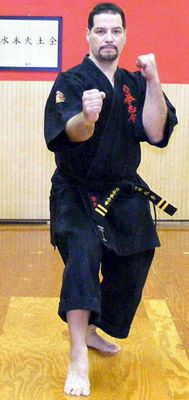
Martialforce.com: When was Kenshi-kai Goju-Ryu created?
Luis Morales: “I believe in 1976. After the passing of Fukuchi Sensei, Hokama Hanshi put the elements of Kenshi-kai into place. The Kenshi-Kai Goju-Ryu was created to preserve what Hokama Hanshi learned from the great masters. The driving force was and still is to promote ‘Old Style Karate’ U.S. Kenshi-kai Goju-Ryu was formed to promote the practice of ‘Old Style Goju-Ryu’ and maintain the principles set by Hokama Sensei.
I believe Hokama Hanshi is a genius and his karate is on another level. His scope of knowledge is boundless. After our first meeting in 1999, he invited me to train with him. Since then, I have traveled to Okinawa numerous times to train with Hokama Hanshi. He has a museum in Okinawa. It is dedicated to all the great masters, in appreciation. He is preserving the Okinawan Martial Arts culture.”
Teacher and Student
Martialforce: What do you say to students who have studied USA Goju or Japanese Goju during the past twenty years and later learned that certain aspects of the arts were never taught to them?
Luis Morales: “I have had a lot of students who came trained in various factions of Goju and have heard their frustrations. I tell them they should not worry because a student is always learning; I also point out to never find fault in what have you learned or in what your instructor have taught you.”
Martialforce: Is your approach to training to increase what they already have?
Luis Morales: “I try to show them the difference, the reasons why our techniques are such and how they can enhance their karate and make it more effective.”
Martialforce: Do you mind if your students study other martial arts?
Luis Morales: “Although I do not mind if my students wish to study other arts, I want them to see that Karate is complete. We have joint locking, takedowns, basic throws, pressure points and kata. There is so much to learn in karate. I have a student who comes to my dojo from upstate New York and a young lady from Pennsylvania. They are willing to travel long distances because they feel I can offer something they were not taught. I currently train with a Black Belt from Gracie Jiu-Jitsu, student of Renzo Gracie. He teaches me Brazilian Jiu-Jitsu and I teach him Tuide and pressure points.”
Martialforce: What are the kata in your system?
Luis Morales: “We do Fukyu Kata Ichi, Fukyu Kata Dai Ni, Kyozai Kata, Gekisai 1 and 2, then Saifa, Seiunchin, Sanseiru, Seipai, Shisochin, Seisan, Kururunfa, Suparenpai and of course Sanchin and Tensho which is the foundation of the system.”
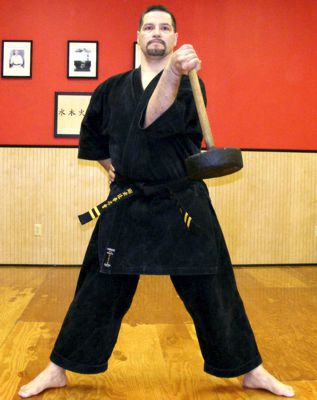
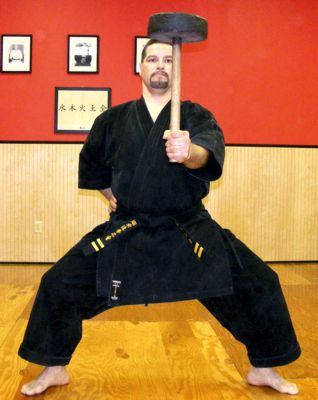
Martialforce: When do you begin teaching Bunkai?
Luis Morales: “Immediately to my adult classes.”
Martialforce: How about the children?
Luis Morales: “Only to those who have a good head on their shoulders, and are determine to train hard with no jiving around.”
Martialforce: “Old school style” training used to teach kata, not according to rank but by body type. Do you teach kata similarly?
Luis Morales: “I teach the kata in order; Bunkai to those who have an understanding.”
Martialforce: Do you teach according to ones’ mindset?
Luis Morales: “I might teach a basic Bunkai or switch to a more advanced Bunkai but again, it is according to their understanding. You have to realize that a lot of the good stuff was not taught in the open. The master instructor would say, ‘William, come Sunday at noon to have lunch.’ So you come Sunday at noon to have lunch, but during that time, you are beginning to learn the secrets. You are shown that you can do this or you can do that, but what you were being taught was the understanding of why. Those lessons are not given to you in an open format like during a class; it is at the discretion of the master.”
Martialforce: Ok, grappling, restraining, and locks, are they in the kata from beginning kata, say gekisai on up? Was this something held back?
Luis Morales: “They are in the kata from gekisai all the way up. Many years ago, it was only taught to the most senior students. During 1905 when Karate was introduced into the public school system, many of those elements were taken away. Various masters taught them but only to their most trusted students.”
Martialforce: How did you become a trusted student?
Luis Morales: “I became a trusted student because I train hard, have an open mind and I’m very respectful. I never badmouth anyone.
My teacher, Hokama Sensei saw this. I have been training with him for ten years. We have an open student/teacher relationship based on mutual respect. If I am uncertain of a particular movement or position, I only need to write and ask him. He will always come back with more than one idea.”
Martialforce: Do you teach theory?
Luis Morales: “Yes. You need it because theory is what is going to help you do your technique effectively when you are older. See right now you are still young, you are 50 I am 51. We still have enough to bang. What will happen when you are 65 and confronted with a young guy like Santana, (a strapping powerhouse)? He is not someone you want to stand toe to toe with because you will get hurt. But, if you understand theory, body alignment, and things like power knockouts and the pressure points, your art will remain invaluable.”
Martialforce: The distinction in Old Style Karate is?
Luis Morales: “To begin with, some examples are cat stance and hand positions are different when you compare ‘Old Style Karate’ to what is referred to as Modern Karate.
No one applies this block (illustrates mawashi uke) and there goes the breakdown. I start teaching the breakdown with the Kata. My teacher teaches like this: Kata three times, breakdown, Kata three times, breakdown. No wasted movement, everything is for a reason. In old style karate, everything has a purpose. Why do you do Bensoku dachi? Reason is to get away from someone but also to learn how to move and cover your whole 360.
Why do you do Shiko dachi? You want to break someone’s stance. Why do Zenkutsu dachi? You have to cover distance. Why do Neko Ashi dachi? It is a finishing technique. If you grab me and keep fighting, I am going to drop into a Cat and break you, break your foundation.
When I am doing joint locking, I want to take away the slack on that particular joint. In Jujitsu, they will grab you and they will go like this (demonstrates a wrist counter and lock). We take all the slack away; we attack the pressure point and then lock it in. Thus, I eliminated all the free space, do the lock and finish as we attack the vital points always the points.
You need to consider body alignment as well. When I change my position, (demonstrates with Santana; does a slight step, twist then locks in, Santana falls to the floor). Thank-you very much. See how it makes it easier? I use technique using body alignment, body placement.
The purpose of this exercise (bends neck back holding tongue in roof of mouth, then exhaling), is to exercise the thyroid. Practicing barefoot stimulates your meridians. All these little things improves your karate a 100 percent.
Tonight when you leave, your karate will have already improved without even practicing physically. You can practice hard but your body can only go so far. I can practice hard and he (pointing towards Santana again), is physically stronger because his body was just inherited that way. But, if I have the principles behind my technique, my Karate is always going to be superior to his.
You are not always going to be stronger or faster than your adversary is. If you have good body alignment, good technique, good body movement you will always improve your Karate.”
Martialforce: Obviously, you cannot teach these principles to students who lack a certain frame of mind or to kids. If you take these out, what makes the old style art beneficial?
Luis Morales: “Good question. They are the elements of concept, theory, body alignment and other sub-arts. All provide advantages to the art.”
Martialforce: Give me an example of a sub-art.
Luis Morales: “An example would be the art of taking of balance.”
Martialforce: Without watering down the art, are you teaching other aspects before a student reaches a level where he can understand advance principles?
L. Morales: “Yes, my teaching offers many of the sub-arts that aside from striking is what Karate is known for: joint locking, pressure points, the art of taking of balance and the aspects of ‘Martial Science.’ The immediate advantage of taking of balance is applying your technique successfully against say a big 300 pound guy.”
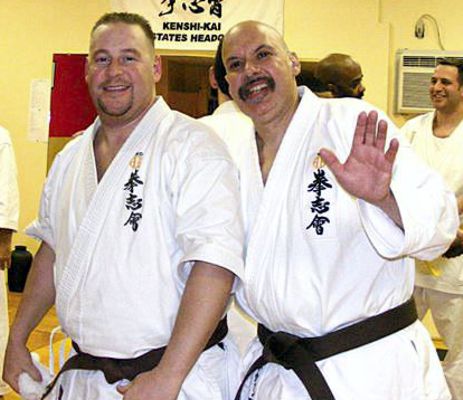
Martialforce: How do you instruct a child with a developmental disability such as autism?
Luis Morales: “At my school in the Bronx, I have several students who are autistic. Our approach to teaching is using repetitive concentration drills and many balance drills. Many have speech impairments and difficulty focusing. These drills improve their abilities to bring together concentration and eye contact.”
Martialforce: And that comes from the art?
Luis Morales: “Yes. There are different methods to improve your concentration, some of which comes from old style Karate. I must emphasize that Karate offers so much more, has so many components. Many modern day practitioners think Karate is only a kick-punch art and then go seek other arts, like Jujitsu or Aikido, in order to learn locking. They do not need to do that because it is already in your Kata.”
Martialforce: With Pressure Points, is there a way of developing tolerance to its effects?
Luis Morales: “Maybe some, if you it just one vital point. When you do Sanchin to develop your body, you are also increasing some level of tolerance. That is why if a student has good acceptance it is ideal to hit the pressure points in combinations of three. Instead of hitting just once, combining the points makes it a completely different ballgame.
Indeed, Martial Science makes the art effective. The body consists of twelve meridians; they are pathways or vessels that transport chi, blood and fluids throughout the body, integrating all the body parts into a unified whole, lung, large intestines, stomach, spleen, heart, small intestine, bladder, kidney, pericardium, triple burner, gallbladder and liver. The body has vital points, which correspond to a specific meridian. Each meridian is represented by a specific element, wood, fire, earth, metal, and water.
The rationalizing of applying the element concept to a specific meridian is that it will explain its effect. Example, if you hit a fire point and a metal point, it is a lethal combination. If you put fire to metal, metal melts. If you were to hit a wood point and a metal point, this is also lethal because metal cuts wood. The application of using the pressure points makes the art a whole different ballgame.”
Martialforce: Does Martial science teach you how to heal?
Luis Morales: “Exactly, the vital points are the same as used in acupuncture; acupuncture uses the five elements, wood, fire, earth, metal, and water. They use the constructive cycle, which I use mostly for healing. However, we use the five elements in the destructive cycle. Wood penetrates earth, metal cuts wood, fire burns metal, which is used for martial purposes. Most important to understanding the use of pressure points is not just about knowing how to negatively affect someone but also how to revive them.”
Martialforce: Is it that people are just not teaching this?
Luis Morales: “They were not taught. All these old masters came up during the modern age and most of them did not learn it and the few that did, do not teach it openly.”
Martialforce: Kobudo, does it also have aspects of vital points?
Luis Morales: “Kobudo has Tuide and when you strike you always have the option to strike pressure points.
Martialforce: Did Miyagi teach this?
Luis Morales: “Miyagi did not do weapons. You have to realize that many people from royalty had a better chance of learning it because they are established in society. My teacher comes from the Chibana Castle so essentially he was taught a lot of the good stuff.”
Martialforce: Taking a different direction, do you teach your style to law enforcement?
Luis Morales: “Yes, I currently have students who are law enforcement officers. There are those who hear about it and are curious. Once they do learn, they’re hooked.”
Martialforce: Do you believe the old style being taught in Okinawa can be preserved?
Luis Morales: “Yes, because it is being taught right here and at my teacher’s dojo.”
Martialforce: For the next generation?
Luis Morales: “Yes. I have great students that are talented, such as this guy (Santana). He is a Fourth Dan and he knows more than you can imagine. I am confident that he and other students will preserve the old way. I have hopes for my son as well. He is 14 years old.”
Martialforce: Did you aspire to become the North American Representative of
Kenshi-Kai Goju Ryu?
Luis Morales: “I never thought about it. I wrote to Hokama Sensei and telling him about a seminar I had done in Canada. The folks who attended joined our group. I recently opened a dojo in Canada. They later joined Hokama’s weapons system. I will be returning to Canada this year to hold two seminars, one in April in Owens Sound Canada and the other in May in Ontario, Canada.
Hokama followed up my letter by requesting that I send him a video of me doing Kata with bunkai, and Kyusho. Several days ago, I received in the mail my 8th Dan ranking as well as my promotion as North America Chief Instructor for Kenshi-kai. Holy Smokes!”
Martialforce: Goju Ryu without theory, is that Kenshi-kai?
Luis Morales: “No, what makes Kenshi-kai distinctive is theory, the use of pressure points and the applications of Martial Science.
To reiterate, Hokama Sensei learned from Seiko Higa and he learned from Seiko Higa top student, Seiko Fukuchi. Also, he learned from Shinpo Matayoshi, one of the great masters. When he trained at Seiko Higa’s dojo, Seiyu Nakosone the famous Tomari-Te Master, used to go there to learn Tensho, so he learned theory from him. Hokama was also good friends with Kanei Uechi, the son of the Uechi Ryu founder. From of these great masters, he learned about theory.”
Martialforce: Explain theory.
Luis Morales: “Theory is the understanding of how things work. It allows you to understand the why. An application example: if you hit one pressure point followed by a hit to another the result is an easy knockout.”
Martialforce: Is this based on Hokama’s teachings?
Luis Morales: “Yes, Hokama taught the pressure points based on the Bubishi. I also studied the principles of Dragon Society International (DSI), its’ pressure points which are based on Chinese principles also applied to acupuncture.”
Martialforce: What made you decide to study with DSI?
Luis Morales: “I attended several of their seminars to learn about pressure points. I was impressed with their presentation, which was informative and well organized. What they demonstrated blew everyone away. DSI style consists of Kyusho-jutsu (vital points art) and Tuite-jutsu (grab hand art). I later went to Virginia to train one on one with Grandmaster Tom Muncy, co-founder of DSI, along with Grandmaster Rick Moneymaker. I joined DSI in 1998. In my opinion what they teach in Kyusho-jutsu is incredible.”
Martialforce: Did Grandmaster Muncy teach you how to snap the power punch?
Luis Morales: “Hokama sensei did, how to use my entire body, but Hanshi Muncy taught me how to relax more and use my breath.”
Martialforce: Did he teach you Tai Sabaki?
Luis Morales: “Yes, though not just Tai Sabaki, but rather more about subtle body alignment. A lot of times you have to step away from your opponent and there’s not enough time, so you have to use angle, body shifting pivoting on the heel or the ball of the foot.”
Martialforce: What direction do you want to see for your schools?
Luis Morales: “A good question, Shihan. I want to ensure that my schools preserve the old style of Karate in the manner in which the masters used to do it. I do not have a huge following. I am told I should get out there and show more of myself. I say, when you are ready to learn something good, your teacher will appear.
Many guys come in and say, “Hey where you been all my life? I have never seen anything like this!” I say, you are here now. As long as I have good people that will preserve the art the way it was taught I am happy and content.”
Martialforce: In closing our interview, I have one last question. Do you have a calling?
Luis Morales: “Yes. I am still learning, right now I am learning from a Japanese master who teaches Okinawan Karate, Shorin Ryu, learning Ki methods and from Hokama Sensei. Karate is beautiful, effective and unbelievable.
I teach autistic kids and they are awesome students. My students are inspirational. My goal, my calling, is to teach you to grow, not only in your karate but to help you grow into a better person. Karate is all about giving good Karma.”

For more information about Luis Morales and North America Kenshi-kai Okinawa Goju-Ryu Karate-jutsu Kobu-jutsu Association visit their website at https://www.kenshikai.org/ and the North America Kenshi-kai Okinawa Goju-Ryu Karate-jutsu Kobu-jutsu Association listing on the Martial Arts Schools and Businesses Directory by clicking on the image on the left.

For more information about Luis Morales and Budo Quest Martial Arts visit their website at North America Kenshikai and the Budo Quest Martial Arts listing on the Martial Arts Schools and Businesses Directory by clicking on the image on the right.

